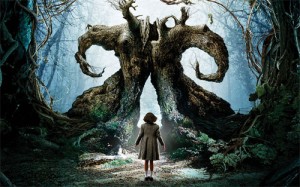Pan’s Labyrinth – Del Torro’s stunning allegorical tale

responding to evil
![]()
Pan’s Labyrinth – Guillermo del Torro
How shall innocence respond to evil? How can the dominance of power be resisted or even defeated? Timeless questions del Torro explores in his stunning allegorical tale. But be warned, this is a dark, at times brutally explicit vision.
Historically human beings have responded to these fundamental questions in two ways: through myths and legends imbued with magical powers; and through the metaphysical narratives of religion. The magical conception is the more ancient. Indeed one might argue that the concept of the miracle is a relic of the magical within a religious perspective. The strength of Del Torro’s film is that he entwines these narrative threads in a tour de force of at times breathtaking imagery.
Ofelia, on the borders of sexuality and womanhood, accompanies her re-married, newly pregnant mother Carmen to the mountains of Spain where her husband Fascist Francoist Captain Vidal is fighting off residual guerrilla resistance in 1944 from Republicans refusing to accept defeat. Ofelia is an imaginative child much attracted through reading, to the magical realm and stories of fairies and fauns. When her tailor father died her mother married Vidal, a customer of the business.
The conflict between innocence and evil is paralleled in two overlapping narratives: the brutal war of attrition between the resistant Republicans and the victorious, Fascist Francoist Nationalists like Vidal, and Ofelia’s magical adventures initiated by her stumbling across a cricket in the forest that she takes to be a fairy. Despite her mother’s plea for her to treat Vidal as her father, it is clear that this sensitive, imaginative child is horrified by Vidal’s aggressive, brutal demeanour.
The real world narrative demonstrates not only Vidal’s absolute power over the local inhabitants, but his ruthless brutality in maintaining it. In the magical realm, Ofelia’s cricket transforms itself into an actual fairy and then leads her back into the forest. She meets with a faun who explains that she is the daughter of the king of the underworld and must undertake three tests in order to prove herself as a genuine daughter of an immortal, worthy to be a princess. These parallel narrative structures offer del Torro perfect opportunities for moral resonance. For example, just as Vidal follows his orders without question, however much brutality fulfilling them may require, so the faun requires Ofelia to meet without question, certain unexplained conditions in her quest. That Ofelia and Vidal respond differently to these absolute demands on their behaviour lies at the moral and spiritual heart of the film.
Ofelia’s mother is treated by a kindly Dr Ferriero and she herself befriended by Mercedes, servant to Vidal. Both are secretly helping the Republican dissidents, creating a constant palpable sense of dramatic tension throughout. Ofelia’s magical quests are accessed through a labyrinth and are superbly realised by del Torro with some startling imagery. In one sequence an unanimated figure sits before an untouched banquet. His eyeballs rest upon a plate before him. The faun has absolutely forbidden Ofelia to eat anything from the banquet, however tempting. Her task to recover a dagger from the room accomplished, as she leaves, she succumbs, despite the remonstrations of her protective fairies, to the temptation to eat one of the succulent grapes from the table, echoing Eve in the Garden of Eden. This act animates the figure and in a wonderfully Dali-esque sequence with the creature’s eyes placed in its hands not its eye sockets, Ofelia has to escape its terrifying pursuit. And adding moral resonance, two of her fairies sacrifice themselves to the creature to enable her to escape.
The final resolution of these dramatic trheads is moving, poignant and elusive. Del Torro, thankfully is too much of an artist to succumb to a reductionist resolution to his latter day morality tale. He touches upon the deepest of our moral dilemmas and sets in counterpoint on one level the realist, irresistible triumph of the necessity of physical might, against the power of the imagination and the extraordinary, indeed irrational determination of human beings to sacrifice all for freedom and justice.
How shall innocence respond to evil? With imagination, love of freedom and justice and a determination to sacrifice all for them. That has been the history of the human spirit and is in the end what del Torro celebrates in this evocative, visually stunning example of cinematic art. Painful, exciting, terrifying, touching and uplifting at one and the same time. As profoundly real as it is genuinely magical, in the best sense of the word. Strong stuff – but not to missed.
Filed under: 4 stars, Europe/World cinema, Fantasy, General, Guillermo del Torro, Philosophical

